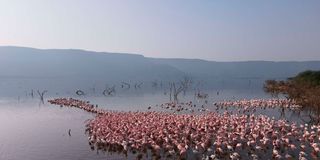Exploring Baringo County, a wildlife haven and nature lover’s paradise

Flamingos in Lake Bogoria, one of the four lakes in Baringo CountY.
What you need to know:
- Sitting in the middle of the most dramatic part of the Great Rift Valley, Baringo is a county of great diversity, providing habitat to different wildlife species.
Baringo County has been in the headlines for the wrong reasons — banditry and cattle rustling. But despite the bad reports, there is a positive side to Baringo that is rarely seen.
The Climate Action team embarked on a journey to explore the county and its beauty; and understand how communities come together in conservation efforts.

Giraffes at Ruko Conservancy on the shores of Lake Baringo on May 30.
Sitting in the middle of the most dramatic part of the Great Rift Valley, Baringo is a county of great diversity, providing habitat to different wildlife species. It has contrasting landscapes, from the forested Tugen hills, to the low lying Tiaty region, Lake Baringo's fresh water, Lake Kamnarok in Kerio Valley, Lake 94, which formed in 1994 after heavy rains, and Lake Bogoria, home to thousands of lesser and greater flamingos.
The county is also known for cultural diversity, where historically, local communities have embraced conservation in one way or another, forming an attachment with wildlife and believing in their spiritual significance — the county's emblem is the Greater Kudu; a large woodland antelope.
Despite the beauty and abundance of wildlife, over the years, Baringo has faced challenges such as poaching, population growth, habitat destruction and charcoal burning.
To address the challenges and conserve their precious flora and fauna, several communities have adopted a conservancy model, which supports wildlife conservation and sustainable livelihoods.
One of the oldest conservancies established in Baringo is the 14,000-hectare Ruko Conservancy, which is accessed via Lake Baringo. Like the neighbouring Laikipia, Ruko was once a rich wildlife landscape with diverse and abundant wildlife. However, poaching and illegal hunting wiped out many of the species. The conservancy was formed by the warring Pokots and Ilchamus communities, living adjacent to the lake, who put their differences aside to protect wildlife.
Today, Ruko is a birders paradise, hosting hundreds of species. It is also home to the biggest bird in the world, the ostrich. Ruko's flagship species are the rare Nubian giraffes, which were reintroduced at the conservancy in 2011.
Ruko has huge potential as a tourism attraction, but it has remained at the establishment level due to the lack of a framework to finance the conservancy. Plans, however, are underway to invest in this wildlife haven.
We head back to the mainland to explore more of the county, and we learn that Baringo may not host all of the Big Five animals, but it does have the lesser-known Small Five.
Francis Cherutich, a guide who has lived in Baringo all his life, tells us about these creatures, some of which are extremely difficult to find.
"We have the Rhinoceros beetle, which has a horn like that of a rhino. We have the Ant lion, which has claws like a lion. They feed on ants. We have the elephant shrew, which has a long trunk that resembles that of an elephant. It eats insects that feed on crops. Buffalo weavers normally stay in a group like African buffaloes and feed on insects such as caterpillars and grasshoppers. We also have the leopard tortoise, which has spots like a leopard. They feed on weeds," he said.
Despite their small size, these five creatures are hugely significant. Each plays an important role and even reduces the need for pesticides. Each one is an indicator of a healthy ecosystem.
From here, we visit Tuiyarus community conservancy, one of Baringo's newest conservancies, which borders Lake Bogoria National reserve. The view is breathtaking, with lush tree canopies spread across the horizon. The hidden ecosystem beneath the thick green carpet of trees is a safe breeding haven for Baringo's flagship animal — the Greater Kudu.
Tuiyarus community conservancy was formed just a year ago when 14 private land owners from Endorois community came together to conserve the wildlife that roamed their land.
Mzee James Ngetich is one of the landowners who sacrificed 115 acres of his private land to the conservancy. He says he did this because as a young man, he benefited from conservation. He hopes that his children will have a bright future due to the conservation model, which will enable them to work in the conservancy and earn a livelihood.
Tuiyaris also has a hidden gem — Maji moto, the river that forms the conservancy's boundary, which hosts turquoise pools.
The next conservancy we visit shows how diverse the landscape in Baringo is. It is Kiborgoch Wetland Community Conservancy that spans about 2000 acres. Women who form Chelaba group, the oldest women’s group in Baringo, are among the conservationists who guard this nine-year-old conservancy. Selina Lorok, the chairlady, explains that the women protect the wetland because they benefit from it. The women carefully walk into the wetlands, which are home to snakes and hippos, to collect dried reeds that they use to make mats.
A larger portion of Kiborgoch is terrestrial, where livestock and wildlife share the land. However, a major problem here has been land degradation. During heavy rains, soil erosion causes more damage, which also leads to inter-community conflicts during drought. However, the formation of this land into a conservancy is one way of protecting the area.
The conservancy model is a work in progress. While many strides have been made, Susan Jepkemoi, the CEO of the Baringo County Conservancy Association, a community-led conservation organisation established in 2017, says there is still more to be done.
"Most communities in Kenya and Africa have not benefited from conservation because it requires long-term strategies and is capital-intensive. With that realisation, conservation is not something you can do within a day, it's long-term," she says.
The association is supported by The Nature Conservancy (TNC). Munira Bashir, government relations and policy director at TNC, explains the investment: "With Baringo, we've been supporting capacity building in terms of governance structures for the regional association for them to be able to support their conservancies. We do that because we believe that if you put strong governance structures in place for communities, they can attract funding and drive conservation on their own. The end product of sustainable conservation in Kenya is investing in conservancies. We know 65 per cent of wildlife seasonally lives outside the protected areas – the animals live in private or community land. And for people to own the wildlife, they need to see these benefits."
Baringo has over 17 registered community conservancies and more than 20 upcoming conservancies that at different levels of establishment.
Additional reporting by Robert Gichira. Watch NTV Wild Talk “Discovering Baringo” TONIGHT on NTV at 8.25pm, or on ntvkenya.co.ke


